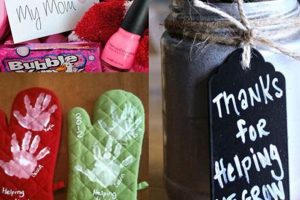The creation of personalized holiday containers, often involving crafting materials and techniques, allows for a unique expression of festive spirit. For example, an individual might choose to sew a stocking from felt, embellishing it with custom-embroidered designs.
This practice offers several advantages, including the potential for cost savings compared to purchasing pre-made items and the opportunity to tailor the design to specific aesthetic preferences or the recipient’s personality. Historically, handmade holiday decorations have served as a cherished tradition, fostering a sense of familial connection and creative expression.
Consequently, subsequent sections will explore various methods for producing these personalized holiday containers, encompassing fabric selection, embellishment techniques, and pattern adaptation strategies, thereby providing a resource for individuals seeking to engage in this creative endeavor.
Enhancing the Personalized Holiday Container Project
The following guidelines provide insights to ensure a successful and aesthetically pleasing outcome when undertaking a personalized holiday container project.
Tip 1: Fabric Selection: Prioritize durable and visually appealing fabrics. Wool felt, cotton canvas, and linen blends are suitable choices due to their texture and ability to withstand embellishment techniques. Consider the color palette and ensure it complements existing holiday dcor.
Tip 2: Pattern Adaptation: Begin with a readily available template and modify it to reflect desired dimensions and stylistic preferences. Adjusting the cuff height or adding gussets for increased volume are common alterations.
Tip 3: Embellishment Techniques: Employ a combination of embroidery, appliqu, and surface embellishments to create visual interest. Seed beads, sequins, and ribbon trims can add texture and dimension to the design. Consider the weight of the embellishments and their impact on the fabric’s drape.
Tip 4: Seam Construction: Utilize reinforced seams to ensure structural integrity. A zigzag stitch or a serged edge can prevent fraying and enhance durability. Pay close attention to the alignment of seams and ensure they are pressed flat for a professional finish.
Tip 5: Lining Application: Incorporate a lining to conceal raw edges and provide a smooth interior. Cotton or muslin are suitable lining materials. Attach the lining securely to the outer fabric using hand stitching or machine stitching.
Tip 6: Personalization Strategies: Incorporate the recipient’s initials, a significant date, or a meaningful symbol into the design. Heat transfer vinyl or stenciled paint can be used to add personalized text or graphics.
Tip 7: Closure Mechanisms: Consider adding a loop for hanging the finished container. Reinforce the loop attachment point to prevent tearing. A button and loop closure can be added to the cuff for added security.
Following these recommendations will optimize the creation of personalized holiday containers, ensuring a durable, aesthetically pleasing, and meaningful result.
The subsequent section will address common challenges encountered during the process and offer troubleshooting strategies.
1. Fabric selection
Fabric selection is a foundational decision in the crafting of personalized holiday containers. The material chosen directly influences the durability, aesthetic appeal, and overall success of the completed item. Careful consideration of fabric properties is therefore crucial.
- Durability and Longevity
The chosen fabric dictates the stocking’s resistance to wear and tear. Sturdy materials like wool felt or canvas ensure the stocking can withstand repeated use and handling over multiple holiday seasons. Conversely, delicate fabrics may require reinforcement or result in a shorter lifespan.
- Aesthetic Qualities
The fabric’s texture, color, and pattern contribute significantly to the overall visual impression. Velvet offers a luxurious appearance, while burlap conveys a rustic charm. The selection should align with the desired aesthetic and complement any planned embellishments.
- Ease of Manipulation
Different fabrics present varying degrees of difficulty in cutting, sewing, and embellishing. Felt is relatively easy to work with, making it suitable for beginners, while slippery fabrics like satin require more advanced sewing skills. The chosen fabric should be manageable for the crafter’s skill level.
- Compatibility with Embellishments
The fabric’s surface texture and weave affect its ability to hold embellishments securely. Closely woven fabrics provide a stable base for embroidery or appliqu, while loosely woven materials may require additional stabilization. Consideration should be given to the intended embellishment techniques when selecting a fabric.
In summary, fabric selection is not merely a cosmetic choice; it’s a functional decision that determines the durability, appearance, and ease of construction of the personalized holiday container. Each of these aspects collectively influences the success and satisfaction derived from the completed DIY project.
2. Pattern design
Pattern design constitutes a crucial element within the creation of personalized holiday containers. The pattern serves as the foundational blueprint, dictating the dimensions, shape, and overall aesthetic of the finished item. Inadequate pattern design can lead to dimensional inaccuracies, structural instability, and an undesirable final appearance. For instance, a poorly drafted pattern may result in a lopsided stocking or one that is too small to accommodate anticipated contents. Conversely, a well-executed pattern facilitates accurate cutting and sewing, resulting in a professional-looking and functional holiday decoration.
The choice of pattern design can significantly impact the complexity of the crafting process. A simple, symmetrical pattern is generally easier to execute, making it suitable for beginners. More intricate designs, incorporating curves, gussets, or asymmetrical elements, demand greater precision and sewing expertise. Some examples include traditional rectangular patterns, contemporary boot-shaped patterns, and customized patterns reflecting specific themes or characters. Adaptations to existing patterns, such as altering the cuff height or adding pockets, allow for further personalization.
In summation, pattern design is not merely an aesthetic consideration but a practical determinant of the success of any personalized holiday container project. A carefully selected and accurately executed pattern minimizes errors, enhances structural integrity, and ensures the final product aligns with the intended vision. Understanding the principles of pattern design, therefore, is fundamental to achieving optimal results in this crafting endeavor.
3. Embellishment techniques
Embellishment techniques constitute a critical component in the successful execution of personalized holiday container projects. The selection and application of embellishments directly influence the aesthetic appeal and personalized character of the finished product. Without appropriate embellishment, the final item may appear generic or lack the intended festive character. For example, the addition of embroidered snowflakes, appliqud reindeer, or beaded accents can transform a plain fabric stocking into a unique and cherished holiday keepsake. The deliberate use of embellishment is, therefore, a primary driver of visual interest and individual expression within the realm of crafting custom holiday containers.
The practical application of embellishment techniques encompasses a broad spectrum of options, each requiring specific skill sets and materials. Embroidery, whether executed by hand or machine, allows for intricate designs and personalized messages to be permanently affixed to the fabric. Appliqu, involving the layering and stitching of fabric shapes, offers a means of creating dimensional effects and incorporating diverse textures. Surface embellishments, such as sequins, beads, and ribbons, provide opportunities to add sparkle, texture, and a touch of luxury. The careful consideration of color palettes, material compatibility, and stitch types are paramount to achieving professional-looking results. Misapplied embellishments can detract from the overall aesthetic and compromise the structural integrity of the piece. Therefore, a thorough understanding of available techniques and best practices is essential.
In summary, embellishment techniques are indispensable to realizing the full potential of personalized holiday container projects. They afford the means to transform a basic fabric structure into a bespoke item reflective of individual creativity and festive spirit. Mastering a range of embellishment skills, coupled with a keen eye for design, is key to overcoming challenges and producing high-quality, visually compelling holiday decorations. The significance of these techniques lies not only in their aesthetic contribution but also in their capacity to imbue each creation with personal meaning and enduring value.
4. Seam strength
Seam strength represents a critical factor in the successful execution and longevity of personalized holiday container projects. Inadequate seam construction directly correlates with a heightened risk of structural failure, particularly under the weight of contents. A weak seam, for instance, may rupture when the stocking is filled with gifts, rendering the item unusable and diminishing its sentimental value. Therefore, the implementation of robust seam construction techniques constitutes a fundamental aspect of producing durable and functional holiday containers.
The importance of seam strength is exemplified in several practical scenarios. Consider a large stocking intended to hold heavier items, such as books or electronic gadgets. If the seams are not adequately reinforced, the weight will place undue stress on the stitching, potentially causing the seams to split. Similarly, stockings frequently used over multiple holiday seasons are subjected to considerable wear and tear, further emphasizing the need for durable seam construction. Techniques such as backstitching, reinforced corners, and the use of heavy-duty thread contribute significantly to the overall strength and resilience of the finished product. A chain stitch is much more effective here.
In conclusion, seam strength is not merely a minor detail but rather a pivotal element in the creation of durable and aesthetically pleasing personalized holiday containers. Prioritizing robust seam construction techniques ensures the item can withstand repeated use and maintain its structural integrity, thereby preserving its sentimental value for years to come. This understanding of the fundamental relationship between seam strength and overall project success is essential for achieving optimal results and avoiding common pitfalls in this crafting endeavor.
5. Lining material
The selection of lining material exerts a considerable influence on the overall quality and functionality of handmade holiday containers. The lining, positioned on the interior surface, serves multiple purposes that extend beyond mere aesthetics. It provides structural support, conceals raw edges, and enhances the visual presentation of the finished product. For instance, the absence of a lining can result in frayed edges becoming visible, diminishing the overall aesthetic appeal and potentially reducing the container’s lifespan due to weakened seams. Therefore, understanding the role of lining material is crucial for crafting durable and visually appealing holiday stockings.
Practical applications of appropriate lining material are diverse. A cotton lining provides a smooth interior surface, facilitating the easy insertion and removal of contents. Furthermore, it prevents embellishments, such as beads or sequins, from snagging on internal threads. Heavier lining materials, such as muslin or canvas, offer increased structural support, particularly for larger stockings or those intended to hold heavier items. The choice of lining material also affects the overall weight and drape of the finished item. Selecting a lining that complements the outer fabric is vital to maintain a balanced and harmonious aesthetic. An example could be a colorful patterned cotton lining paired with a solid-colored outer fabric.
In summary, the correct selection and application of lining material are integral to the success of a handmade holiday container project. The lining contributes to structural integrity, aesthetic appeal, and overall functionality. Challenges associated with improper lining selection, such as fraying or snagging, can be mitigated through careful consideration of fabric properties and intended use. This understanding is essential for achieving a professional and long-lasting result, aligning with the broader theme of crafting high-quality, personalized holiday decorations.
6. Personalization details
The incorporation of personalization details constitutes a pivotal element in the crafting of bespoke holiday containers. These details, ranging from embroidered names to themed appliqus, transcend mere aesthetic embellishments. They serve as tangible representations of individual connection, transforming a generic holiday item into a uniquely meaningful artifact. The absence of personalization often renders the resulting item indistinguishable from mass-produced alternatives, thus failing to capture the intended sentiment of a handcrafted gift. A simple example is a stocking adorned with the recipients initials, their favorite animal, or a symbol representing a significant event in their life. This act of personalization transforms the stocking from a mere container for gifts into a cherished memento, reinforcing the relationship between giver and receiver. The omission of such details reduces the impact of the effort invested in the endeavor.
The application of personalization details extends beyond superficial decoration. It presents opportunities for functional enhancements tailored to the recipients specific needs or preferences. For instance, the inclusion of reinforced pockets for specific items, such as smartphones or small books, caters to practical considerations. Similarly, the selection of fabrics and embellishments aligned with the recipients individual style or hobbies demonstrates a thoughtful and considerate approach. The act of personalizing a holiday container, therefore, represents a deliberate effort to create a functional and emotionally resonant object. Successful personalization requires careful consideration of the recipient’s personality, preferences, and lifestyle. It avoids generic motifs in favor of elements that hold specific meaning for the individual.
In conclusion, personalization details are not merely decorative additions but are integral to the essence of the custom-made holiday container. They infuse the creation with individual meaning, transforming a generic item into a cherished keepsake. The challenges associated with personalization lie in selecting details that are both meaningful and aesthetically pleasing, requiring a thorough understanding of the recipient’s preferences. By prioritizing personalization, the craftsperson elevates the project from a simple construction exercise to a heartfelt expression of individual connection.
Frequently Asked Questions
The following questions address common inquiries related to the design and construction of custom holiday stockings.
Question 1: What fabric type is most suitable for a durable personalized holiday container?
Durable fabric options include wool felt, canvas, and heavy cotton blends. These materials resist wear and tear and provide a stable base for embellishments. Lightweight or delicate fabrics may require reinforcement.
Question 2: How can pattern alterations improve the functionality of personalized holiday containers?
Pattern adjustments, such as increasing the size of the cuff or adding gussets for increased volume, enhance functionality. Consider the intended contents when modifying the pattern.
Question 3: Which seam construction techniques provide optimal reinforcement for holiday stockings?
Reinforced seams, created using a zigzag stitch, a serged edge, or a backstitch, enhance durability. Corner reinforcement is particularly important in high-stress areas.
Question 4: What considerations are crucial when selecting embellishments for personalized holiday containers?
The weight and compatibility of embellishments with the chosen fabric are key considerations. Heavy embellishments may require additional support. Ensure embellishments are securely attached to prevent detachment.
Question 5: How does the selection of lining material affect the overall quality of a holiday stocking?
Lining material conceals raw edges, provides structural support, and enhances the interior finish. Cotton, muslin, or heavier fabrics are suitable choices, depending on the intended use and desired level of support.
Question 6: What are effective methods for incorporating personalized details into a holiday container design?
Personalization methods include embroidery, appliqu, heat transfer vinyl, and stenciled paint. The chosen method should reflect the skill level of the crafter and the desired level of detail.
Proper execution of these considerations will contribute to the creation of a durable, functional, and aesthetically pleasing personalized holiday container.
The subsequent section will address potential challenges encountered during the construction process and provide corresponding troubleshooting strategies.
Concluding Remarks on Personalized Holiday Container Creation
The preceding discussion elucidated critical factors in the production of bespoke holiday containers. Topics ranged from optimal fabric selection and pattern design to the application of embellishment techniques, the importance of seam strength, the strategic use of lining materials, and the integration of personalized details. Proficiency in these areas directly influences the structural integrity, aesthetic appeal, and overall success of individualized creations.
Understanding the complexities of holiday container design empowers individuals to move beyond mass-produced alternatives and cultivate lasting traditions. It is anticipated that continued exploration and refinement of these techniques will further elevate the quality and significance of personalized holiday decorations, enriching the celebratory experience for years to come.







